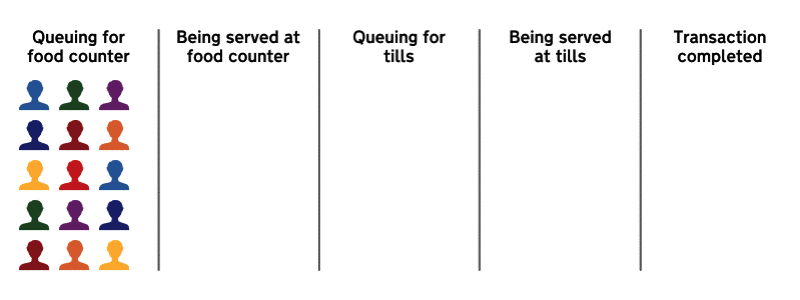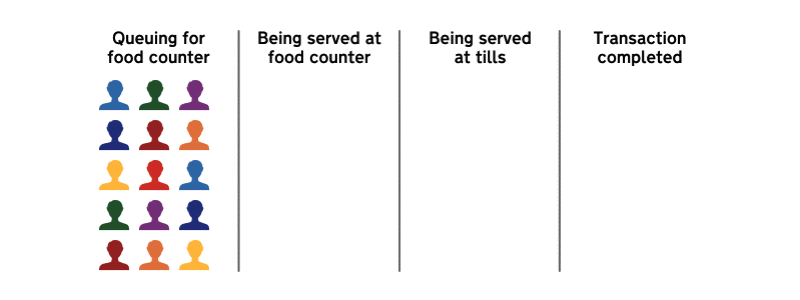I was in Wasabi last week buying lunch, and I noticed a peculiar phenomenon; everyone was queuing wrong.
It wasn’t their fault. They probably didn’t notice it. In fact, it’s probably more accurate to say they were being queued wrong. They were victims of an invisible decision — and I only noticed it because of this book and many conversations with clever people at work.
Demand and flow.
My local Wasabi has two food service areas — one for cold food and one for hot — and between them is a payment area with 4 tills. These tills are split to serve the different food services; 2 for cold, 2 for hot.
How the food service works with the tills is an example of poor demand management resulting in poor service.
Cold food transactions are pretty simple.
The cold food area is self-service; you pick up your food, and you take it to the till. The only constraints on how fast you complete your transaction are how fast:
- customers can get to a fridge (usually slowed down by having to barge past hungry hordes)
- the cashiers can process customer payments
This is a relatively straight forward process; and it’s pretty speedy. There’s rarely a queue for the cold food counter because there’s very little waste as part of the system. In effect, failure has been designed out of the system.
Hot food transactions are in two parts. Chaos ensues.
A hot food transaction is broken into two parts. Each customer is effectively served twice.
The first part is selecting and being served the food. Hot food is counter-service; the Wasabi hot menu is made of a combination of separate components, and each meal must be served to order.
The second part is paying. To pay, you stay in the same line, but it’s a new queue. Your food server queues your food up along the counter and the cashier serves the next available customer.
You might assume this is a very efficient way of running the service, and that it gets you served fastest. Practically, it’s very slow; customers get disjointed service and find themselves repeating their orders at multiple staff.
The reality of the service doesn’t match up with the theoretical design. The ideas of specialisation, optimisation and economies of scale are at play — and they don’t work, resulting in a poor experience for me as a customer.
Specialisation, optimisation and economies of scale.
I suspect Wasabi’s hot food queuing system is based on assumed economic wisdom. Specifically that:
- making each staff member do a specialised task (serving food or taking payments) optimises each part of the transaction
- by optimising each part of the transaction, the overall transaction is more efficient and more customers can be served
- there are economies of scale to be achieved by specialisation because optimised parts of the transaction are more efficient and therefore take fewer staff to administer
Experience and academia tells me this assumed wisdom works for car production, but not service industries.
Optimising the whole service, not just the parts.
The problem with Wasabi’s hot food service is that they’ve optimised each part of the service, but not optimised the whole service. These are not the same thing.
An optimised counter service is creating an unmanageable backlog at the tills. For Wasabi, the constraint on the speed of service for hot food is not in how fast the food can be put into cardboard containers — it’s in how fast the cashiers can process payments.

A more efficient service would not be based on improving the speed of each part of the service, but on improving flow and end-to-end service times. By focusing on the whole, you implicitly optimise the parts.
You may be thinking there will be perfectly valid reasons why Wasabi has a division of labour at the counter; health and safety being one.1 So let’s talk about a coffee, because our major chains have very different ways of serving their customers that illustrate the same problem.
Take Costa and Caffé Nero. The queuing system in Costa (and in Starbucks, for that matter) is almost identical to Wasabi - though the elements are reversed. You queue for the till to pay, then you queue again whilst a different person makes your coffee.
Making coffee takes longer than pressing buttons on a till. The result is a backlog at the coffee counter, where the barista (not unreasonably) can’t keep up. This is a frustrating experience for me as a customer because I never know where I am in line or whether the latte put down is for me (because the three people in front just ordered the same drink).
Compare that to the experience at Caffé Nero. You’re dealt with by one person; they take your order, make it, and take your payment. You still get queues, of course, but the flow of customers is constrained in different ways.

Customers are dealt with end-to-end. It’s every barista’s job to manage the whole queue. As a customer not only does it feel better, it feels faster - and that’s because it is. There’s no need to queue twice and there’s no system induced backlog - that service failure has been designed out of the system.
Now, the constraint isn’t created by any one part of the service. The constraint is in the amount of resource you put into the system as a whole; whether you rota 3 or 4 baristas on each shift, whether you buy 2 espresso machines or one. As a customer I’m more tolerant of the queue itself because I know the only delay to my service is in getting to the front of one queue — not two.
Funny, what you learn at lunch time
I know from my time working in front-line services that staff are told to complete tasks as quickly as possible. You aren’t told to manage entire transactions from start to finish.
When you realise that, to the customer, completing a transaction is more important than being passed to the next part of the transaction, you begin to see how services can be improved.
When it comes to multi-part transactions, you don’t get economies of scale by specialisation; you get backlogs and bottlenecks. So here’s some free advice for Wasabi and Costa - optimise your queues for flow, not for speed; it’s better for your customers.
Footnotes
Wasabi staff wear hygienic hair nets and gloves when serving food. Accepting these are necessary, having staff remove and replace these gloves each time they use a till would be both wasteful and slow down their service. ↩︎